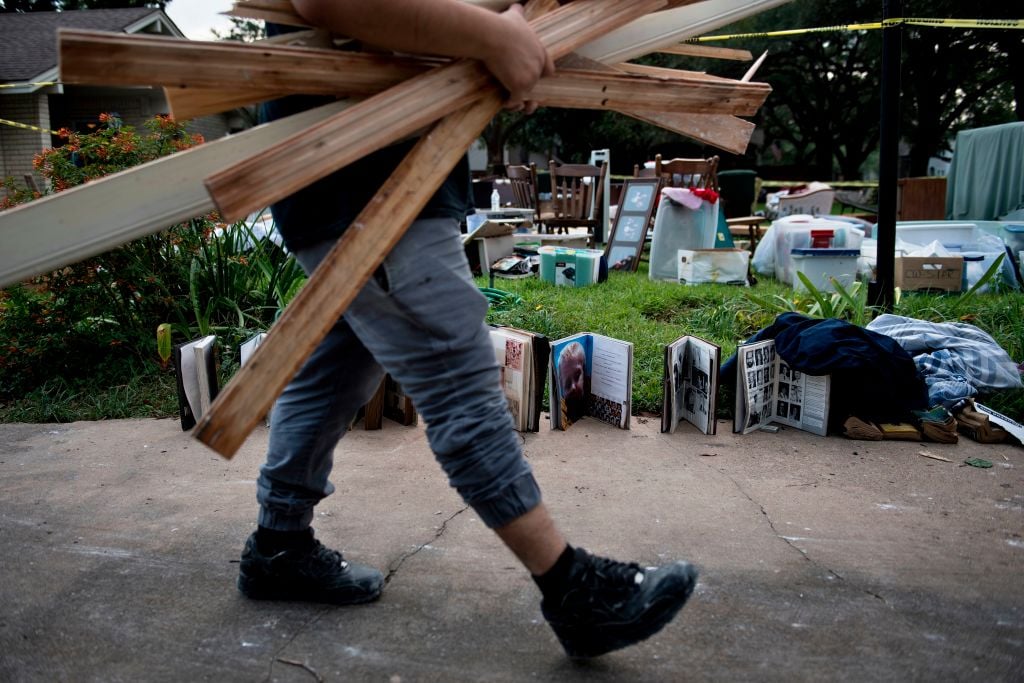
As Hurricane Irma plows through the Caribbean and barrels toward Florida, thousands are jamming the highways to evacuate flood zones. Little feels certain. But an unlikely group of experts—art conservators—have banded together to do what they can, manning a 24-hour hotline that offers practical methods to treat water-damaged art. A small army of volunteers is also on standby to survey the damage in person after the skies clear.
On September 5—soon after Hurricane Harvey swept through Texas and before Irma approached the US—the American Institute for Conservation of Historic and Artistic Works (AIC) and its affiliate foundation FAIC released a statement to cultural organizations around the world, offering free emergency response assistance and advice for those affected by the storm. The organization has also been lighting up social media to spread information about how to keep collections sheltered in the path of severe weather and how to salvage items that have been damaged.
Artist Andrea Garland and her husband artist Jeffrey Holmes, outside their home in the Upper Ninth Ward, 2005 in New Orleans. Photo by Ethan Miller/Getty Images.
The National Heritage Responders hotline is staffed by a crew of 100 conservators, registrars, archivists, and other collection-care professionals who volunteer on a rotating basis to manage the phone line 24/7. During periods of heightened volume—like the days and weeks after Harvey, and in the run-up to Irma’s landfall—the hotline is staffed by an even wider range of experts who specialize in different materials including photographs, books, and textiles.
Once connected, the conservator walks callers through the first steps to mitigate mold growth and arrest further damage. The organization also offers boots-on-the-ground assistance, dispatching members throughout the country to assess the scale of damage at a particular site. Someone is always within driving distance: It typically takes between four to seven days for a volunteer to arrive.
The app has easy-access tips for collections ranging from ceramics to electronics. Courtesy of the NCPTT, © 2017 AIC.
Another important resource is the Emergency Response and Salvage Mobile App, a handy mobile tool created by the National Center for Preservation Technology and Training. Although designed for museum professionals, the free app offers useful information for anyone dealing with water damage.
Here are a few tips from these dedicated experts to help keep precious items safe from the storm.
1. Organize Your Efforts First
- Make sure the gas and electricity are turned off and that the area is cleared for re-entry before you begin to assess damage.
- A little extra planning at the beginning will go a long way—especially for insurance purposes. Document the situation as you go: Take pictures and keep notes for reference.
- Cool and dry spaces are the best spots to examine objects. If you can, keep air circulating with fans.
- A mixture of seven parts alcohol and one part water is effective for mold prevention, Steve Pine, a conservator at the Museum of Fine Arts in Houston, told the Houston Chronicle. But be mindful: Flood water can contain hazardous materials, so wear safety masks and gloves before handling anything that has been submerged.
2. Take Extra Care with Framed Paintings and Works on Paper
- Immediately take the work out of the frame, but do not separate paintings from their stretchers.
- Keep wet paintings horizontal, with the paint-side up, preferably elevated. Keep them out of heat or sunlight.
- If the work is stuck to the glass of the frame, do not try to peel it apart. Leave it in the frame to dry with the glass side down.
3. Soggy Photos? Do Not Despair
- Wet photographs that are stuck together should be immersed in clean water and swished around until they come apart. Then, lay them out to dry.
- If the photographs are damp or partially wet, experts have a secret weapon to salvage them: the freezer. Interleave the photos with wax paper, place them in resealable bags, and freeze them until you can spread them out to thaw and dry. Textiles can also be frozen after being briefly submerged in clean water.
- The air-dry technique is another tried-and-true method favored by museum conservators. Place an absorbent material (such as un-inked newsprint, paper towels, or blotters) underneath wet objects. Then, lay them out in a cool, dry space stocked with fans. Do not hang wet items, as they will be unlikely to remain intact.
4. Freeze Your Wet Books, Too
- If you have more than one book stuck together, rinse off any grime while the books remain closed. Then, pack them spine down in a resealable bag or sturdy container and put them in the freezer.
- Individual books can be air-dried, standing upright.